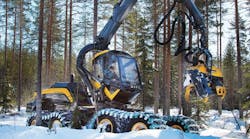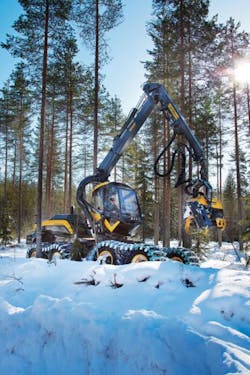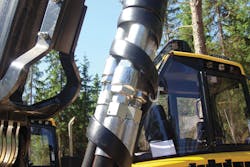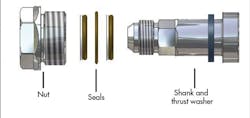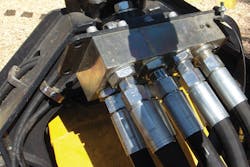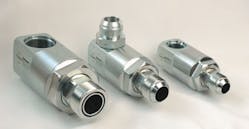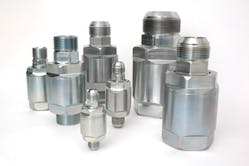In the logging industry, ever-higher levels of automation have increased log-harvesting productivity. One case in point is the Scorpion, an eight-wheeled harvester by Finnish manufacturer Ponsse Vieremä. The Scorpion processes standing timber into cut-to-length logs ready for transport from the forest to a finishing mill. Its frame is comprised of three parts linked by rotating joints. Front and rear frames are each linked to the center cab frame by these joints. The middle frame is kept level along its longitudinal axis by hydraulics. In fact, a leading feature of the Scorpion harvester is its stabilized design, which comes from its eight wheels and active stabilization system.
The Scorpion’s front and rear frames tilt according to the contours of the terrain. Its eight wheels may be tires or paired in with treads (front and rear, right and left) for traction in extremely rough terrain and harsh winter weather. The vehicle’s operator sits on the centerline of the vehicle in an ergonomically designed cab. The frame design keeps the pivoting point as low as possible and minimizes tilting, preventing the operator from swaying sideways.
Once a tree is selected for harvesting, the operator maneuvers the crane so that the jaws on the Scorpion’s harvesting head grip the tree’s trunk as a saw blade cuts the tree at its base. The log is then pivoted to a horizontal position, where hydraulic motors rotate wheels that pull the tree trunk through the harvesting head. As the trunk passes through the harvesting head, it strips off the tree’s branches and cuts the log to a predetermined length. After the first section is cut, the remaining length of tree trunk passes through the harvesting head, is stripped of its branches, and is cut to length. This continues until the entire usable length of the tree is cut, then the operator moves on to the next tree.
Hydraulics gives Scorpion its sting
Handling the heavy mass of the tree trunks requires an incredible range of motion and strength, often in demanding weather conditions. Not surprisingly, hydraulics is the only form of power transmission that can deliver this type of performance. Mounted at the end of the Scorpion’s crane is Ponsse’s H7 harvester head. Once properly positioned, the agile H7’s jaws encircle and clutch the trunk of the tree to be harvested. The harvester head then proceeds with its stripping and cutting operations.
A considerable amount of torsional movement is required of hoses that route pressurized hydraulic fluid between the crane arm and harvesting head. Consequently, hydraulic hoses must be mounted on swivels to prevent twisting hoses’ reinforcing construction, which would cause premature hose failure. In extreme cases, torque transmitted through the hose can actually loosen its end fitting.
The Scorpion operates at pressures reaching 4,350 psi. At this pressure, traditional ball-bearing hose swivels can wear out prematurely. For this reason, after several years of testing, Ponsse engineers selected swivels of a different design: ball-less swivels from Taimi Hydraulics in Canada.
Swinging into swivels
Swivels accommodate rotational movement of hydraulic machine parts. Without them, even the best of hose assemblies would fail prematurely from repeated twisting. Given all the complex movements required of the Scorpion, torsional loads on its hydraulic hoses would quickly fatigue their reinforcement if not compensated for by swivels.
Ball-bearing swivels are effective when hydraulic operating pressures were 3,000 psi or lower. At higher pressures, however, a different approach to swivel design became necessary, which is why Ponsse considered using Taimi’s ball-less swivels.
Taimi’s swivels are more costly than the ball-bearing version, but Ponsse personnel believed that the potential benefits far outweighed the cost differential. In order to be sure they were making the right move, Ponsse officials tested the ball-less swivels for four years in Finland and in the United States before deciding to use them on new machines they build.
Protection from pressure spikes
A shank-nut assembly is the key to the ball-less swivel design’s effectiveness. The long span of the shank allows for optimal load distribution. The shank is inserted through a seal assembly and into the nut. A thrust washer, made of a self-lubricating polymer, provides low friction for torsional movement and also provides shock-absorption properties. The nut then fastens the rotating shank securely to a housing, block or manifold. The swivel’s sealing characteristics are achieved in two stages: by contact under pressure between the thrust washer and the nut, and by two sets of oversized Viton O-rings and back-ups. A key benefit of this design is high wear resistance in the field.
Ball-bearing swivels have a lower load capacity because of the small contact area between the balls and their races — thin arcs support the swivel’s entire load. Consequently, both balls and races can wear out quickly, thereby increasing the torque needed for rotation and eventually hindering the free motion of the swivel. This, in turn, can lead to leaks and, ultimately, to swivel and hose failure. Similarly, side loads applied to ball bearing swivels reduces life of the component. In the ball-less design, the load on the swivel is applied more uniformly around its circumference, thus reducing the effect on life of the swivel.
Another valuable characteristic of Taimi’s ball-less swivels is their pressure spike protection (PSP) feature, which dampens pressure spikes. The swivel acts as the hydraulic equivalent of a voltage surge protector used with electronic equipment by keeping its components from being damaged in the event of an energy surge. When a pressure spike arises in a hydraulic line, a thrust washer made of engineered plastic prevents the surge of energy from reaching the swivel’s seals.
The ball-less swivel design also prevents the swivel from pulling apart under load, thus reducing leaks, failures, and downtime. In the ball-bearing swivel, gradual wear to the bearings and races will result in increased play between mating components. This play can be the beginnings of a leak, but when the wear becomes excessive a hydraulic pressure peak or strong pull on the hose may well disconnect it. The result is a safety hazard, a fluid leak, and costly downtime.
Successful results
Since Ponsse began specifying PSP swivels into its original equipment, the swivels don’t leak, the machines perform better, stay cleaner, operate with less downtime, and spill less oil into the environment. The ball-less swivels do not pull apart, significantly reducing the risk of oil spills. Because they do not use ball bearings, they will not seize, thereby increasing hose life. Ponsse is also using ball-less swivel cartridges, which offer the same benefits as in-line swivels. However, they can be directly inserted into a manifold, so the size, length, and cost of an assembly are significantly reduced.
Sebastien Tremblay is Managing Director at Taimi Hydraulics, St. Prime, Canada. For more information, call (418) 686-6868, ext. 707, or visit www.taimi.ca.
Ponsse (www.ponsse.com) equipment is available in North America from its facility in Rhinelander, Wis. Click here to see a video of the Scorpion in action, and click here for a video showing the flexibility of Ponsse equipment afforded by Taimi’s swivels.
